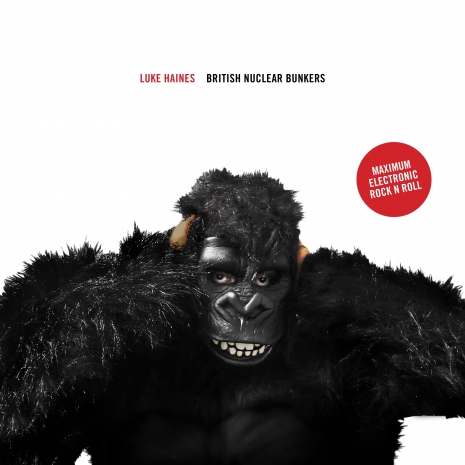
With seemingly every single article written about him for the better part of the past two decades declaring Luke Haines “underappreciated” or referring to him as England’s “best kept secret” or some such, you might be forgiven for assuming that Haines is a bit of a cult figure in his native Britain.
And if he’s a cult figure there, then what does that say about his profile in America? Regrettably, he doesn’t really seem to have much of one here. Not that this is his fault. It’s your fault. But it’s mine, too. I’ll explain.
So WHO, you are (probably) asking, is this Luke Haines character anyway? In the 90s Haines was the leader of the Auteurs, an incendiary guitar-based group (with a “cello player”) who emerged fully-formed with the Mercury Prize-nominated New Wave (they lost to Suede) in 1993. The Auteurs’ high point comes with their Steve Albini-produced masterpiece After Murder Park in 1996, in which Haines perfects the art of softly singing as if he is approaching you slowly and deliberately with a drawn knife and the crack, well-rehearsed band generally blow the doors off of any other rock and roll group making records that year. It’s the equal of any classic album you can name and surely the subject of an upcoming 33 ⅓ series book.
When his interest in his own band waned, Haines formed Black Box Recorder, a sort of archly cynical answer to Saint Etienne, with former Jesus and Mary Chain drummer John Moore and vocalist Sarah Nixey. They had a hit single with “The Facts of Life” and left behind three nearly perfect pop albums and one “worst of” odds and sods collection. After that Haines went on a righteous solo trip, which is now the subject of a new four CD box set from Cherry Red, Luke Haines is Alive and Well and Living in Buenos Aires (Heavy, Frenz - The Solo Anthology 2001-2017) a follow-up volume to 2005’s box set Luke Haines is Dead.
I caught on very, very slowly to Luke Haines’ work myself. Although I actually bought my first Haines CD in 1996—and absolutely loved it—it was the Baader Meinhof concept album, which was not released under his name and didn’t have especially informative liner notes. I did not delve any deeper into the Auteurs at the time as I had the idea that they were some kinda Britpop group and that wasn’t my cup of PG Tips and stepped-on cocaine. Had I done so, I’d have seriously freaked out and Haines would have immediately entered my pantheon of godlike geniuses. But I did not dabble further despite seriously digging Baader Meinhof and playing the shit out of it. (Frankly as much as I love that album, it’s not something that one necessarily requires more of.)
Several years later I became infatuated with the Black Box Recorder number “Andrew Ridgley” (sic) but I did not make any connection to the Baader Meinhof album. It was only when I picked up Haines’ (must read, utterly essential) autobiography Bad Vibes: Britpop and My Part in Its Downfall that I finally figured it all out. It’s hard for me to imagine anyone reading that (side-splittingly hilarious) book without wanting to hear the accompanying musical soundtrack. And I do mean ALL OF IT. And this is the musical rabbit hole that I’ve fallen into for the past year or so. I honestly don’t think that I have ever listened to (pretty much) just one artist this intently, or for this long. (The only time even close is when I first discovered Big Youth.)
In fact, our puppy basically only heard the After Murder Park album for the first six months of his life and to this day whenever he hears the first chords of the first song (”Light Aircraft on Fire”) he goes absolutely berserk sprinting around the house like a shot, with great violence, like he’s a slobbering cartoon Tasmanian devil. Another Auteurs’ album opener (Now I’m a Cowboy‘s “Lenny Valentino”) has a similar effect on him: First he runs around frantically, and then when Haines starts singing, he stops, points his nose straight up to the ceiling and begins to howl along. Even if his cute canine vocalizing is a bit out of tune, clearly he approves when I slap these particular elpees on the turntable and he lets me know it. (I’ve always wanted a dog with good taste in music. He’s a big Zappa head too, but not the later “comedy” stuff, more an original Mothers fan. Good boy!)
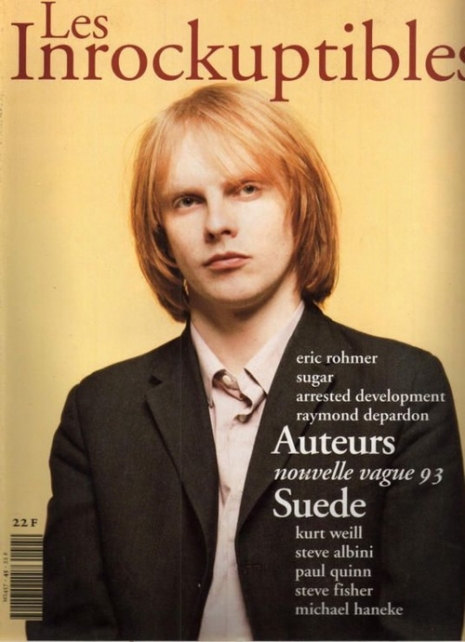
Portrait of the artist as a young man
So yeah, Luke Haines’ relative obscurity in America is surprising, given not only the stellar standard of, well, just about every single thing he’s ever released (even his mediocre songs—judged by his standards, I mean—are still pretty fucking great) but the breadth of his long career and the depth of his quite extensive and extremely high quality back catalog. You’d surely think that many more people on this side of the Atlantic would have picked up on him along the way, as he’s been active since the late 80s. Haines is the ultimate “rock snob” heroic artist, being an intense rock snob himself, he’s probably the most culturally literate musician of his generation and in my (n)ever so humble opinion, he’s the very best English songwriter of this era, ahead of Jarvis Cocker (not prolific enough) and Momus (too eccentric) who are the sole two I’d place in his rarified company. If you find yourself constitutionally unable to read MOJO magazine—and do not enjoy music made by “the young people”—then Luke Haines is likely to be your savior from all of that.
I mean, someone has to be the best British rock musician. That only makes sense, right? And I happen to think Luke Haines is the very best. Comparing him to most of today’s pop stars is like comparing a master mason to someone capable of building a competent lean-to shack. Like comparing John Dos Passos to Dan Brown or Peter Cook to Dudley Moore. It just took me a damned long time to finally realize what I was missing out on and I’m supposed to know about such matters of cultural importance. [“But it’s my job!” he exclaimed plaintively. On the other hand, hey I got to discover one of the best extensive back catalogs in recent musical history for the first time at my advanced age, so lucky me.]
I took an informal poll of several friends—rock snobs all of ‘em, including record store, recording studio and label owners—to see how many were Luke Haines fans besides me. There was exactly one (and he is by far the hippest guy who I have ever met in my entire life, so this was no surprise). The rest answered as you would doing the “sort of, not really” motion with your hand and squinting or simply ignored the query entirely. (If no less of a maven’s maven than our own Howie Pyro has only recently gotten turned on to Luke Haines’ music himself, well that makes me feel slightly less out of it.)
One friend of mine asked “He’s really English isn’t he?” Well… yes, he is that—which is nothing to be ashamed of most of the time—but it’s not like Haines is a Marmite sandwich either. If you’ve ever dug the Kinks or Pulp (or Monty Python or Stewart Lee), you shouldn’t have a problem with any of it. Admittedly I’m probably the most likely Yankee Haines fan you are apt to find: around the same age as he is, Haines and I clearly grew up listening to the same bands and our pop culture obsessions seem fairly congruent. I also lived in Britain for a while, so a song about Enoch Powell isn’t going to fly over my head, nor would one alluding to the Yorkshire Ripper for that matter (although I did find myself googling “Bugger Bognor,” Kendo Nagasaki and Parsley the Lion, but I promise you that I am better off for it). If “really English” is a problem for you, then don’t start with an album like 9½ Psychedelic Meditations on British Wrestling of the 1970s & Early ‘80s—which might be described as “really English” to be sure, but mark my words you will get around to that one eventually—and instead dive in with his concept album New York in the 70s, which has songs about Lou Reed, Jim Carroll, the NY Dolls, William S. Burroughs and Alan Vega. (A certain percentage of our readers who have never heard of Luke Haines until today just decided that they absolutely need to hear this album right about fuckin’ now. They are correct.)
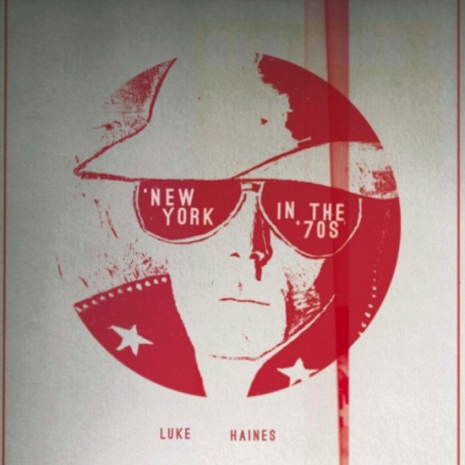
Haines does paintings of Lou Reed, the Monkees and British wrestlers of the late 70s and early 80s and sells them via his Outsider Art website for a reasonable price. He’s currently taking commissions for Xmas.
Another pal asked whose reputation would Luke Haines compare to, in terms of other obscure English musicians, for American fans? Andy Partridge? No, not really as XTC had several hits in America and the Auteurs never did. Julian Cope? Kind of, but he’s also too well known here. Bill Nelson maybe? Nope. Gavin Friday? (shakes head, plus he’s Irish). Roy Wood? Robyn Hitchcock? Matt Johnson? (Definitely not Matt Johnson.) He’s got much in common with Elvis Costello, in particular his often bilious and spiteful lyrical content, but Elvis Costello wishes he could write a song like “How Could I Be Wrong,” “Big Daddy Got A Casio VL Tone” or “I’m a Rich Man’s Toy” (and besides that, he’s far too famous). The only one who readily comes to mind (for me) is probably the great Neil Innes. Like Haines, he’s got a very specific thing that he does—brilliant at being himself at all times, even in character—and both men are multi-instrumentalists of the highest order and master lyricists. Both can mimic and ape the style of other musicians with great precision when they want to (Haines’ take on Suicide or the Incredible String Band is every bit as good as Innes’ wicked Elton John or his justly celebrated Beatles pastiche) and they can both make a decent living doing their own brands of “outsider music” and keeping themselves amused. This is not to imply that their music is in any way similar, as that is not the case. (There is no American artist whatsoever—none that I can think of at least—with whom Haines compares career-wise or otherwise in case you are wondering.)
Although divvying it up between the Auteurs, Black Box Recorder and his solo work would seem to make the most obvious sense, Haines himself has further subdivided his solo career into three distinct phases: “professional rock ‘n’ roll,” his “no man’s land” period and his “unprofessional rock ‘n’ roll” period. Professional rock ‘n’ roll would encompass the Auteurs, BBR and his early solo efforts until around 2003, while his no man’s land era might be best described as his “I have no idea about what’s currently going on with popular music and cannot give less of a fuck phase” phase (which included two years working on an unproduced piece of musical theater called “Property”) and this lasted until about 2008. After that comes “the best part of the trip” as per none other than Jim Morrison hisself. This is the bit where the artist is freed from external constraints and does whatever he or she wants to do, i.e. the shamanic stage of rock ‘n’ roll. (Think Robert Calvert’s Captain Lockheed And The Starfighters for an historical example of the blueprint Haines often follows). It was here when Haines recorded his NYC rock ‘n’ roll concept album, his moody instrumental analog synth opus British Nuclear Bunkers and Adventures in Dementia, his fifteen-minute long “micro-opera” about a Mark E. Smith impersonator whose Winnebago vacation comes to a swift end when his caravan hits Ian Stuart of the white power skinhead band Skrewdriver. With the release of last year’s ritual magick agit prop longplayer Smash the System, Haines’ magick Maoist magus initiation was complete. And what have YOU done, lately?
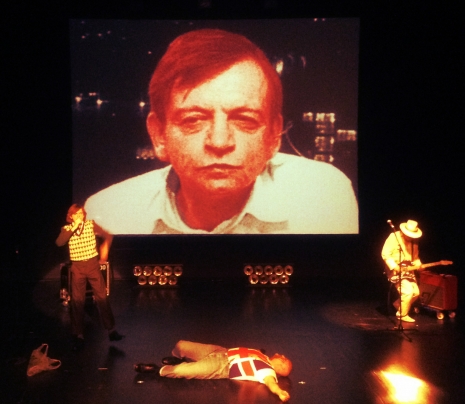
If I’ve not convinced you yet that you need to take a deep dive into the discography of Luke Haines right now, then buddy, I simply cannot help you. He’s making some of the very, very best (and smartest) music of the past three decades, and most American rock fans—including the very people people who would appreciate it THE MOST (like my own circle of rock snob pals, most who remain indifferent to my insisting they get on the Haines train, stat)—have never even heard of the guy.
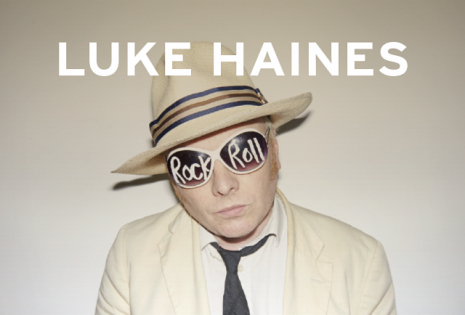
That’s unfortunate, but still it’s an opportunity: When is the last time you discovered a “new” artist with a back catalog of well over twenty stone classic albums going back 25 years? A discography that references by name Peter Hammill, Klaus Kinski, Marc Bolan, ISB, Ulrike Meinhof’s missing brain, Gary Clail(?!), Lenny Bruce, rocker with a messiah complex Vince Taylor, Aleister Crowley, Bruce Lee, Kenneth Anger, the Viennese Actionists, Moholy-Nagy, Roman Polanski, the Monkees and the aforementioned former Wham! guitarist? On one album cover he’s dressed as Hugo Ball. He’s even got a song about the “Silent Twins,” June and Jennifer Gibbons; a bonkers children’s album narrated by Nighty Night’s evil genius Julia Davis (where Nick Lowe is a badger); and a song where he openly fantasizes about murdering British artist Sarah Lucas.
I could go on and on, but I’ve done my bit. Now it’s up to you.
“British Nuclear Bunkers”
“Off My Rocker at the Art School Bop”
“Smash the System”
Haines with the Auteurs doing “The Upper Classes”
Luke Haines, “Accidental Britpop Inventor and Author” on NOISEY’s series ‘The British Masters’ with John Doran
Luke Haines interviewed by Matt Bristow